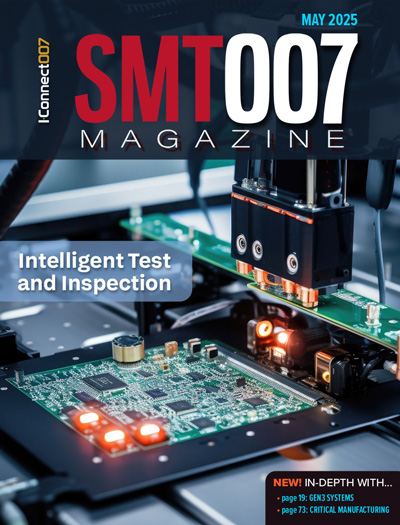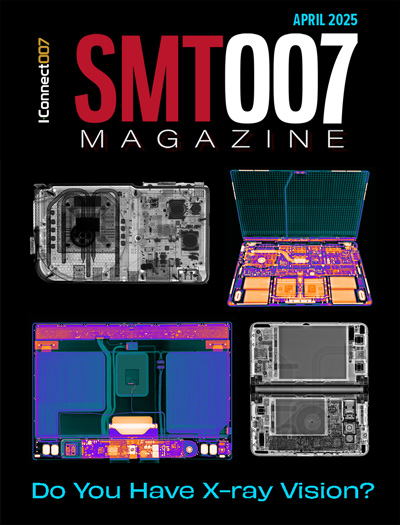-

- News
- Books
Featured Books
- smt007 Magazine
Latest Issues
Current Issue
Moving Forward With Confidence
In this issue, we focus on sales and quoting, workforce training, new IPC leadership in the U.S. and Canada, the effects of tariffs, CFX standards, and much more—all designed to provide perspective as you move through the cloud bank of today's shifting economic market.

Intelligent Test and Inspection
Are you ready to explore the cutting-edge advancements shaping the electronics manufacturing industry? The May 2025 issue of SMT007 Magazine is packed with insights, innovations, and expert perspectives that you won’t want to miss.

Do You Have X-ray Vision?
Has X-ray’s time finally come in electronics manufacturing? Join us in this issue of SMT007 Magazine, where we answer this question and others to bring more efficiency to your bottom line.
- Articles
- Columns
Search Console
- Links
- Media kit
||| MENU - smt007 Magazine
Achieving Long-term Stability in the SMD Placement Process
December 31, 1969 |Estimated reading time: 5 minutes
This article provides a short description of the MCT process, together with the essential fundamentals of placement accuracy. It then introduces a special calibration method which allows for placement accuracy testing to help meet today's pressing market demands. By Günter Schiebel
The current universal trend toward miniaturization, while increasing performance and reducing costs, inevitably must lead to even greater exploitation of the process in all areas of SMT. For example, high-performance placement system users expect the new developments of suppliers to result in a significant increase in the placement throughput while simultaneously improving placement accuracy. As far as the most important aspect of placement placement accuracy is concerned, the user correctly expects specified values to be maintained over several years. These specified values typically are verified for the placement machine customer on the supplier's own premises as part of a machine capability test (MCT).
MCT Process
 Figure 1. Graphic representation of an MCT result.
Figure 1. Graphic representation of an MCT result.
Standard deviation and deviation of the average value from the nominal value of a placement system, two core variables for placement accuracy, are measured as part of an MCT. The MCT is performed in the following sequence: First, a certain minimum number of glass components are placed on a glass board into adhesive foil. Then the placement deviation of all placed glass components is determined in X, Y and q using a high-precision measurement machine. The measurement machine then calculates the placement offsets (deviation of average value from nominal value) in the relevant positioning axes X, Y and q.
The MCT result represented graphically in Figure 1 yields the following core placement accuracy values:
Standard deviation σ = 8 μm
Placement offset μ = 6 μm.
Generally, we can expect the placement deviations to correspond to normal Gaussian distribution, allowing conversion to a wider statistical basis of, for example, 3 or 4. With reference to the statistical basis 4 σ so often used, the placement system specified above would have an accuracy of 32 μm.
Placing the derived precision in relation to a required tolerance limit then assesses machine suitability for a specific requirement. The machine capability index (cmk) has proven most suitable for this. It typically is used to assess the process capability of machines.
The cmk can be used to calculate the placement accuracy once an upper and lower specification limit (USL and LSL) has been defined.
As limit values usually are symmetrical, we can perform the calculation with a simplified specification limit SL = USL = - LSL, as shown in Figure 1.

null
The following cmk results for the conditions presented in Figure 1 and a specification limit of 50 μm defined by the customer:

null
The cmk therefore evaluates the spread and average deviation (placement offset μ) of the placement position in relation to three times the value of the standard deviation σ
How do we deal with the statistical variables sigma, cmk and defects per million (DPM) rate in practice? In electronics manufacturing today, it is expected that the cmk will be greater, even significantly greater, than 1.33. A cmk of 1.33 also indicates that a 4 σ process capability has been achieved. A process capability of 6 s, which so often is a requirement today means that the cmk must then be at least 2.66. In electronics production, the DPM number usually is used for practical reasons because every defect produces costs. The relationship between statistical bases 3, 4, 5 and 6 σ and the corresponding DPM rates are established below:

null
Here is a practical example of its use: In an application in which the greatest packing density is required (e.g., mobile phone), the placement accuracy requirement for 0201 components might be 75 μm.
Scenario 1: We rely on the placement accuracy of 75 μm/4 σ specified by the supplier. In this case, we can expect that of one million placements, no more than 60 will be outside the ±75 μm window
Scenario 2: An MCT produced a cmk of 1.45 based on a certain specification limit. Because a cmk of 1.33 precisely defines a 4 σ process, we can expect a defect rate resulting from placement deviations of significantly below 60 DPM.
Placement Offset Optimization
 Figure 2. Principle for determining the placement offset.
Figure 2. Principle for determining the placement offset.
If, in the SMT production process, it is suspected that the entire placement pattern on the printed circuit board (PCB) has moved significantly in a particular direction because of external mechanical effects, the placement equipment must be recalibrated. This placement offset therefore must be reduced as far as possible. Surface mount device (SMD) electronics manufacturers with a large number of placement systems perform placement offset optimization in a similar way to MCT and use an additional measuring machine. The resulting placement offsets in the relevant positioning axes X, Y and q are entered manually in the placement system for the purposes of compensation.
One method of placement-offset optimization that is integrated into the placement machines is described below.
The idea here is to allow a similar measuring procedure to run in the placement machine, which usually is used as part of an MCT. The aim is that the machine determines a placement offset μ in X, Y and q, which then is used in such a way that it no longer occurs.
The entire process is performed as follows: The largest possible number (e.g., 48) of glass components is placed on a glass board with double-sided adhesive foil. Each of the glass components has reference marks on its outside edges. Reference marks also are located on the plate in the immediate vicinity of the component reference marks (Figure 2).
Directly after placement, four sequential images of the corresponding reference marks on the board and component are taken with a PCB camera. Then the placement offsets in X, Y and q determined by the evaluation program and accepted by the user are transferred into the relevant machine data memory areas. Conventional manual entry of the offsets is no longer necessary. As this integrated method uses relative measurement rather than absolute measurement, the positioning precision and dynamic response of the placement system do not adversely affect the quality of the results. Only the image resolution and quality of the PCB camera are significant. This described and patented method therefore has measurement machine properties.
The following example shows how the cmk of 1.33 can be increased to 1.92 with integrated placement offset optimization.
The following initial conditions are assumed:
SL = 50 μm
Standard deviation σ = 8 μm
Placement offset μ = 18 μm
Original cmk:

null
 Figure 3. Graphic representation of placement offset optimization.
Figure 3. Graphic representation of placement offset optimization.
Reducing the placement offset to, say, 4 μm as shown in Figure 3 results in a significant improvement of the cmk value.
The cmk after optimization of the placement offset:

null
A placement machine installed in the production line can be upgraded to the highest possible placement accuracy without the need for complicated, expensive and often unavailable measuring machines. More or less by simply pressing a button for the duration of the optimization process, the placement system is converted into a high-precision measuring machine.
GÜNTER SCHIEBEL, strategic product manager for SMD placement machines, may be contacted at Siemens Production and Logistics Systems AG, PL EA 1 V PM, 81359 Muenchen, Germany, Rupert-Mayer-Strasse 44; 49 89 722 26581; Fax: 49 89 722 24260; E-mail: guenter.schiebel@mchrm.siemens.de


